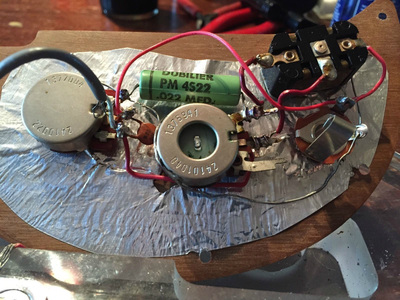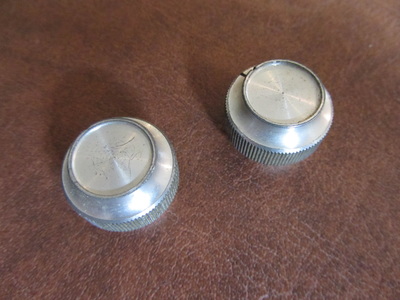What do original Dan Armstrong electronics look like?
The electrical spec for vintage Dan Armstrong guitars was largely unchanged during the 1969 - 1971 manufacturing run and included a volume control, tone control, selector switch, two tone capacitors and an output jack. Within that framework, however, were several variations in components and wiring format. As shown below, we've divided these different wiring specifications into 'Early', 'Mid' and 'Late', which evolved as Ampeg purchased new components and changed the function of the 3-way switch.
Above, first-generation Dan Armstrong wiring diagram as printed on the back cover of the Care & Maintenance brochure supplied with each guitar or bass. Note that the model numbers are G-1 and B-1, respectively, meaning that this wiring diagram applies to the 1969 and 1970 instruments, prior to the March 1971 change in the wiring spec. (described below).
Below, is an excerpt from an early DA owner's manual explaining the functions of the guitar switch. The early manuals were printed on 8" x 11" sheets and stapled together. The manual was later redesigned in the form of a brochure, which made it easier to fit into the case and matched the format of other DA marketing materials (such as the price list).
Below, is an excerpt from an early DA owner's manual explaining the functions of the guitar switch. The early manuals were printed on 8" x 11" sheets and stapled together. The manual was later redesigned in the form of a brochure, which made it easier to fit into the case and matched the format of other DA marketing materials (such as the price list).
|
'Early' 1969 electronic specification.
The distinguishing feature of the early electronic spec is a CTS volume pot coupled with a Stackpole tone pot. The pots have different physical characteristics, in that the CTS pot has a flat, smooth back, while the Stackpole pot has a dimpled ring in the back. Another early feature is an orange-bodied tone capacitor, sourced from Mullard. And although it's hard to see from just looking through the back, the early wiring layout is also less precise than on later versions. The CTS volume pots are stamped with the electrical code 1376920. The first three digits (137) identify the manufacturer as CTS. The next two digits are the year of manufacture (here 1969) and the last two digits are the week of manufacture (20th week of 1969 or somewhere in the week beginning May 12). Although not precise, the May 1969 date on the early volume pots is consistent with a mid-1969 start date for production, as Dan Armstrong's were introduced to the dealer market at the NAMM show, which ran between June 22 - 26 in that year. The tone pot for A166D carries the code 304-6807 (printed on the side, not back), with the 304 denoting Stackpole as the maker and specifying a manufacturing date in February 1968. Why did Ampeg buy potentiometers in early 1968, probably well before it had even seen the Umanov DA prototypes? We believe these pots were being used on another Ampeg product at the Linden factory, and it was a simple matter to just grab some excess inventory to initiate Dan Armstrong production in mid-1969. The tone pot on A166D is also stamped 100K AUD 2410111, denoting its resistance value, audio (logarithmic) taper, and probably an individual part number at Stackpole. The CTS/Stackpole potentiometer set seems to have been used for about the first 220 guitars, as A305D (205th guitar) has these features, while A327D (227th) has gone to the next configuration. Our best guess is that the 'Early' pot configuration was used during the first 3-4 months of production, possibly from June 1969 to September 1969. |
|
The primary tone capacitor (shown as C2 in the above schematic) was manufactured by Mullard. These capacitors are known as "tropical fish" capacitors, due to the various colored stripes along the body, which are color-coded to indicate capacitance value. These capacitors were used throughout 1969, but ultimately changed over to Cornell-Dubilier caps in early 1970.
At right, NOS Mullard .033 microfarad 250v capacitors. |
|
But what does C1 do?
The small brown disc capacitor soldered to the volume control (shown as C1 in the above schematic) is known as a "bleed' capacitor, and is designed to offset reduced treble response as the volume control is turned down. Single-coil pickups are said to be particularly affected by the rolloff of treble frequencies. To mitigate this problem, C1 becomes increasingly "in" the circuit as the volume control is turned down, augmenting the higher frequencies to maintain tone. For those interested in a comprehensive analysis of this topic, click here to access the full online article by Alan Ratcliffe. |
|
'Mid' specification electronics. A few months into production in 1969, Ampeg apparently began to run out of the Stackpole pots, which resulted in the tone control pot being sourced from CTS. As shown in the pics at right, the code on the tone pot is now "1376941, meaning that the pots were manufactured in the 41st week of 1969, or somewhere in early October.
After a couple hundred guitars, Ampeg also ran out of the original 1969 volume pots. Notice that A679D, at right, now carries a volume pot manufactured in the 4th week of 1970 (1377004). Despite the precise dates printed on each potentiometer, it is important to keep in mind that Ampeg purchased its supplies in batches, so one pot code ended up being used across hundreds of instruments. Thus, trying to date Dan Armstrongs by pot code alone is futile. Also during this time frame (early 1970), Ampeg changed the value of the tone capacitor from .033 mfd to .022 mfd, and began sourcing this part from Cornell-Dubilier. These large green capacitors - known as "Greenies" in the trade - continued in use through the end of the run in 1971. The "Mid" electronic configuration (i.e., two CTS pots and the original wiring schematic) appears to cover well over half of total Dan Armstrong guitar production. We estimate this period as beginning somewhere around November 1969 and ending February 1971. Date Reversion...Shown at right is A1221D, where the volume date code has reverted back to 1969 (1376920), whereas earlier 1970 guitars such as A950D had 1970 volume pots...so what happened? We can only guess, but maybe Ampeg found some extra '69 pots from somewhere else and threw them into the Dan Armstrong parts bin. Or the distributor was trying to move aged '69 inventory in 1970 and ran a special... Whatever the reason, it does illustrate the problem of trying to date Dan Armstrong's solely by the pot code - only rarely do they match up. |
1971 Wiring Change. In March 1971, Ampeg published Product Bulletin # 17 which covered changes in the wiring of the 3-way guitar switch and introduced a switch for the DA bass. For the guitar, there would now be two different treble roll-off options (Positions 1 & 3), with the middle position taking the tone control out of the circuit entirely (maximum treble response). The volume control is now in the circuit at all times. The bulletin also included a diagram of how to modify older guitars to the new wiring spec (shown below), and also stated that the new wiring spec would apply to guitars with serial numbers above A2000D. The change in wiring prompted an update to the schematic in the Owner's Manual (shown above), which now refers to the guitar as model ARM G-2 and the bass as ARM B-2.
|
'Late' specification electronics.
Shown at right are several examples of the final electrical spec, including the revised switch format and the last batch of volume/tone pots. CTS pot codes here are 1377036 for the volume potentiometer and 1377035 for the tone control. This would place the manufacturing date in September 1970, and this batch of potentiometers appears to have been in use through the end of the run in 1971. Shown at right are wiring examples from A2179D, A2224D, A2241D, and A2762D. Note the long leads on the tone control and the somewhat cleaner wire dress as compared to earlier versions. |
|
D-Shaft Potentiometers. The machined aluminum volume and tone knobs used on Dan Armstrong guitars are identical to the knobs used on Ampeg's popular V-4 amplifier line. Since the V-4 amps seem to have been in development right around the time that Ampeg was working on the Dan Armstrong instruments, it would have been a cost-effective move to specifiy a common part.
Using D-shaft potentiometers in guitars and basses was certainly not a typical practice with other manufacturers (such as Gibson), who generally used the more common 'split-shaft' pots where a plastic control knob is simply pressed onto a splined shaft. The major benefit of a D-shaft potentiometer is that the knob is much more secure, and will never loosen to the point where it either spins on the shaft or falls off. Although it's hard to see from the photos at right, the inside of each knob has a flat piece of spring steel that compresses against the potentiometer shaft when the shaft is inserted into the knob. This creates the necessary force to keep the knob secure, while allowing for removal during cleaning or service. When removing these knobs, however, be careful NOT to place excessive force on the formica pickguard, which is brittle and prone to cracking. The added expense of D-shaft pots also means that these parts were not manufactured in huge volume back in the day, so sourcing replacements is difficult. We are aware that one prominent Ampeg-related supplier (Fliptops) has resorted to hand-machining flats on newer round-shaft potentiometers in order to get them to work in older Ampeg amps. So be kind to your volume and tone pots - they're going to have to last! |






























